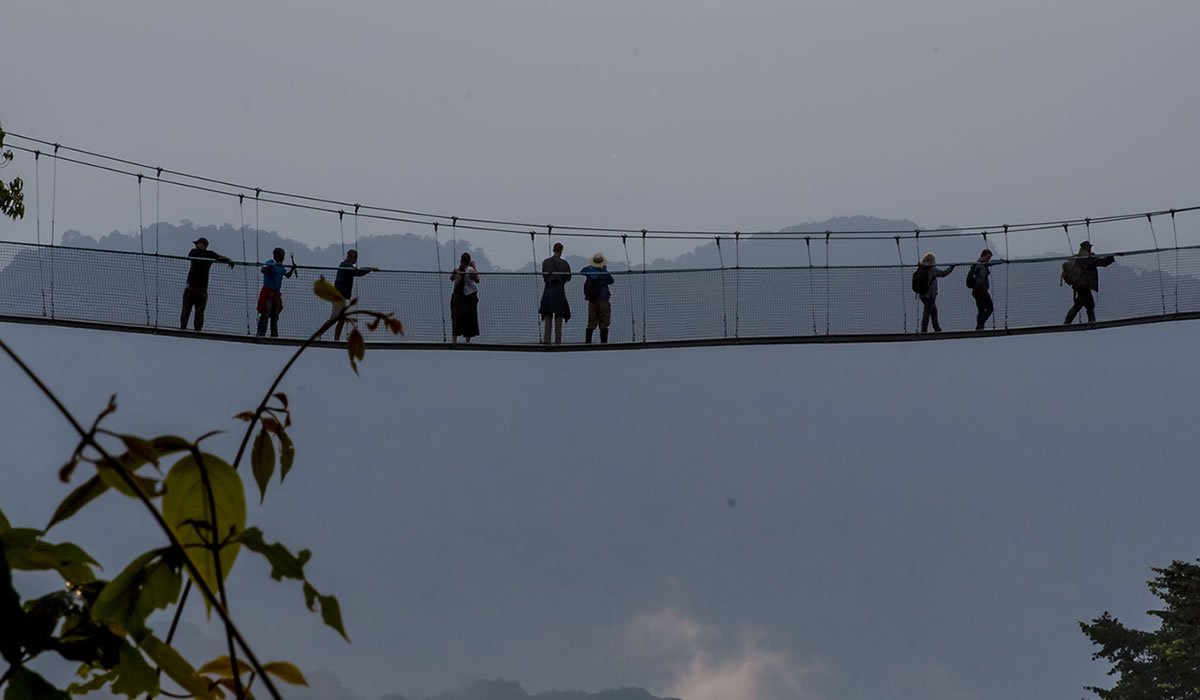Rwanda’s Nyungwe Forest National Park is one of Africa’s most ancient rainforests, a place where nature unfolds in its most pristine form. Located in the southwestern part of Rwanda, this lush tropical forest is home to rich biodiversity, breathtaking scenery, and one of the most iconic tourist attractions in East Africa, the Canopy Walk in Nyungwe Forest. Suspended high above the forest floor, this aerial bridge offers tourists a once-in-a-lifetime opportunity to experience the forest from an entirely new perspective. The canopy walkway provides spectacular views of endless treetops, mist-covered valleys, and a chorus of wildlife sounds, making it one of Rwanda’s most thrilling eco-tourism experiences.

Discovering Nyungwe Forest National Park
Nyungwe Forest National Park is a vast expanse of montane rainforest covering over 1,000 square kilometers, making it one of the largest protected high-altitude rainforests in East and Central Africa. The park is a biodiversity hotspot, boasting over 1,000 plant species, 322 bird species, 75 mammal species, and 13 species of primates, including chimpanzees, colobus monkeys, and L’Hoest’s monkeys.
The park lies at elevations ranging from 1,600 to 2,950 meters above sea level, which creates a cool, misty climate that enhances its mystical beauty. It is also the source of several rivers, including the Nile and Congo tributaries, making it ecologically significant not only for Rwanda but for the entire African continent.
Beyond its natural wonders, Nyungwe Forest holds immense cultural and historical value. It is considered sacred by local communities, who have long viewed it as a place of healing and spiritual connection. Today, it stands as a symbol of Rwanda’s commitment to conservation and sustainable tourism, drawing eco-conscious tourists from across the world.
The Canopy Walkway – A Thrilling Adventure Above the Forest
The Canopy Walk in Nyungwe Forest is one of the most exciting and unique attractions in Rwanda. Built in 2010 with support from the USAID and the Rwanda Development Board, the walkway is the first of its kind in East Africa and one of only a few in the entire continent.
The structure is a 160-meter-long suspension bridge set 70 meters above the forest floor, offering panoramic views of the treetops and surrounding landscape. The walkway is divided into three sections, with the central segment being the longest and highest point of the experience. As tourists step onto the narrow bridge, they find themselves walking through a world of mist, leaves, and bird calls, a surreal feeling that combines excitement with serenity.
From this vantage point, tourists can look down upon the dense canopy of Nyungwe and watch birds flitting between branches or spot primates swinging gracefully through the trees. The experience is both exhilarating and meditative, as the vastness of nature unfolds in every direction.
For many visitors, the Canopy Walk is the highlight of their Rwandan adventure, a perfect blend of adrenaline and awe that leaves lasting memories.
The Canopy Walk Experience
The Canopy Walk begins at the Uwinka Visitor Center, which serves as the main gateway to Nyungwe Forest. After a short briefing from park rangers, tourists embark on a scenic guided hike along the Igishigishigi Trail, a 2.1-kilometer route that leads to the walkway. The trail takes about 30 minutes to an hour, depending on one’s fitness level, and meanders through dense forest filled with ferns, orchids, and towering mahogany trees.
Along the way, knowledgeable guides share fascinating insights about the forest’s ecology, wildlife, and medicinal plants. The forest floor is alive with activity, from chirping insects to rustling monkeys, setting the tone for the adventure ahead.
As tourists approach the suspension bridge, anticipation builds. The first few steps can be thrilling, especially for those afraid of heights, but the sturdy design and safety measures soon inspire confidence. Once on the bridge, the experience becomes pure magic. The forest stretches endlessly below and around, sunlight filters through the canopy, and the cool mountain air fills the lungs.
The entire canopy walk experience takes about two hours, including the hike to and from the bridge. It is suitable for most fitness levels, although a moderate level of physical ability is recommended. Comfortable hiking shoes, light rain gear, and a camera are must-haves for those planning to capture the unforgettable views.
Wildlife and Birdlife Along the Canopy Walk
Nyungwe Forest is a paradise for wildlife enthusiasts and birdwatchers. While walking along the canopy bridge or the trails leading to it, tourists may spot various primates, including L’Hoest’s monkeys, blue monkeys, and Ruwenzori colobus monkeys. Occasionally, lucky tourists may even glimpse a chimpanzee high in the trees, though they are more commonly seen during dedicated chimpanzee tracking excursions.
Bird lovers are especially rewarded on the Canopy Walk. Nyungwe is one of Africa’s most important birding destinations, home to several Albertine Rift endemics that cannot be found elsewhere. Among the 322 recorded bird species are the Rwenzori Turaco, Grauer’s Swamp Warbler, Purple-breasted Sunbird, and Handsome Francolin. The canopy provides one of the best vantage points to spot these colorful and rare species, as many of them live in the upper forest layers.
Butterflies are another delightful presence, with hundreds of species fluttering through the air, adding vibrant color to the green landscape. The symphony of birds, insects, and rustling leaves creates an immersive natural soundtrack that heightens the entire experience.
Best Time to Visit Nyungwe Forest and the Canopy Walk
The Canopy Walk in Nyungwe Forest is open year-round, but the best time to visit depends on personal preferences and weather conditions. Rwanda’s climate is generally mild, but Nyungwe’s high altitude means it can be cooler and wetter than other regions.
The dry seasons, which occur from June to September and December to February, are ideal for canopy walking and hiking. Trails are less slippery, visibility is better, and wildlife spotting is easier. However, even during the rainy seasons (March to May and October to November), the forest remains spectacular, with lush vegetation and fewer crowds.
Because Nyungwe receives regular rainfall, tourists are advised to carry waterproof clothing, sturdy shoes with good grip, and protective gear for cameras. Early morning walks are especially beautiful, as mist often lingers over the forest canopy, creating an enchanting atmosphere perfect for photography.
Accommodation Near Nyungwe Forest National Park
Tourists visiting Nyungwe Forest have a variety of accommodation options ranging from luxury lodges to mid-range hotels and eco-friendly guesthouses. Many of these establishments are strategically located near the park entrance, offering easy access to the Canopy Walk and other activities.
Luxury options include One&Only Nyungwe House, a world-class eco-lodge set within a tea plantation on the park’s edge. It offers stunning forest views, gourmet dining, and guided nature activities, making it perfect for luxury tourists.
Mid-range options include Nyungwe Top View Hill Hotel, which offers panoramic views of the forest and comfortable cottages, and Gisakura Guest House, which provides simple yet cozy accommodation ideal for budget-conscious tourists.
These lodges not only provide rest and comfort but also promote eco-friendly practices that align with Rwanda’s sustainable tourism vision.
Other Activities in Nyungwe Forest National Park
While the Canopy Walk is the main attraction, Nyungwe Forest offers several other exciting activities for tourists. Chimpanzee tracking is one of the most popular experiences, allowing tourists to observe our closest relatives in their natural habitat. Early morning treks through the forest provide unforgettable encounters with these intelligent primates.
Colobus monkey tracking is another rewarding adventure, as Nyungwe is home to one of Africa’s largest troops of colobus monkeys. Nature walks and hiking trails, such as the Kamiranzovu Waterfall Trail and Imbaraga Trail, offer additional opportunities to explore the forest’s breathtaking scenery.
For bird enthusiasts, guided bird watching tours are available throughout the park, led by expert ornithologists who help spot and identify rare and endemic species. Additionally, tourists can visit nearby tea plantations to learn about Rwanda’s tea production process, blending cultural and natural experiences in one trip.
Importance of the Canopy Walk for Conservation and Tourism
The Canopy Walk in Nyungwe Forest plays a vital role in promoting eco-tourism and environmental conservation in Rwanda. By attracting visitors from around the world, it generates revenue that supports the protection of the forest and its wildlife. Local communities benefit through employment, guiding opportunities, and tourism-related businesses, which reduces pressure on forest resources.
Moreover, the Canopy Walk helps raise awareness about the importance of forest ecosystems. Tourists who experience the breathtaking beauty of Nyungwe from above often leave with a deeper appreciation for nature and a stronger commitment to conservation.
The walkway also serves as a symbol of Rwanda’s transformation into one of Africa’s leading eco-tourism destinations. It represents the balance between adventure and sustainability, allowing people to enjoy nature without harming it.
The Canopy Walk in Nyungwe Forest is more than just a thrilling attraction; it is an immersive journey into the heart of one of Africa’s most remarkable ecosystems. From the exhilarating bridge walk to the peaceful forest trails, every moment spent in Nyungwe connects tourists with nature in its purest form.
Whether you are an adventure seeker, birdwatcher, photographer, or nature lover, this experience offers something truly extraordinary. The combination of stunning landscapes, rare wildlife, and cultural richness makes Nyungwe Forest a must-visit destination for anyone exploring Rwanda.
As Rwanda continues to champion sustainable tourism, the Canopy Walk stands as a shining example of how conservation and adventure can coexist harmoniously. Walking above the treetops of Nyungwe is not just an activity, it is a celebration of nature, resilience, and the boundless beauty of Rwanda.

